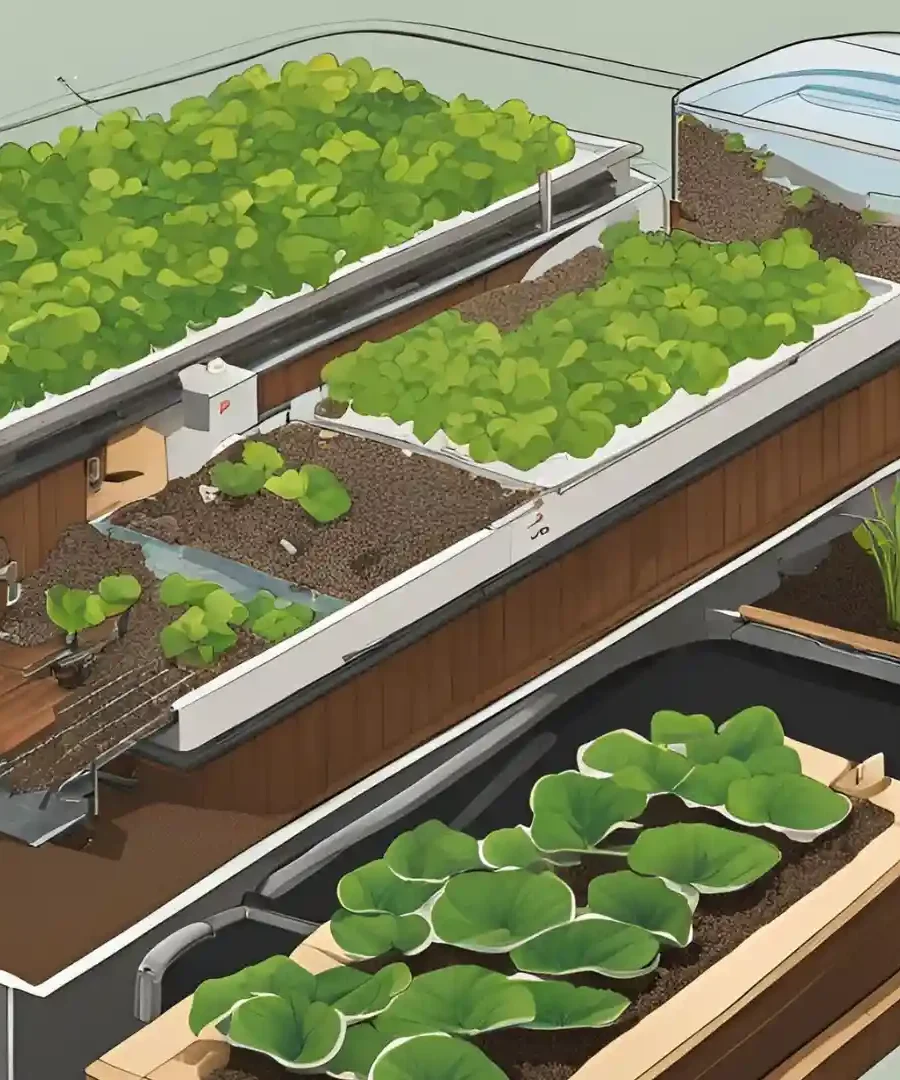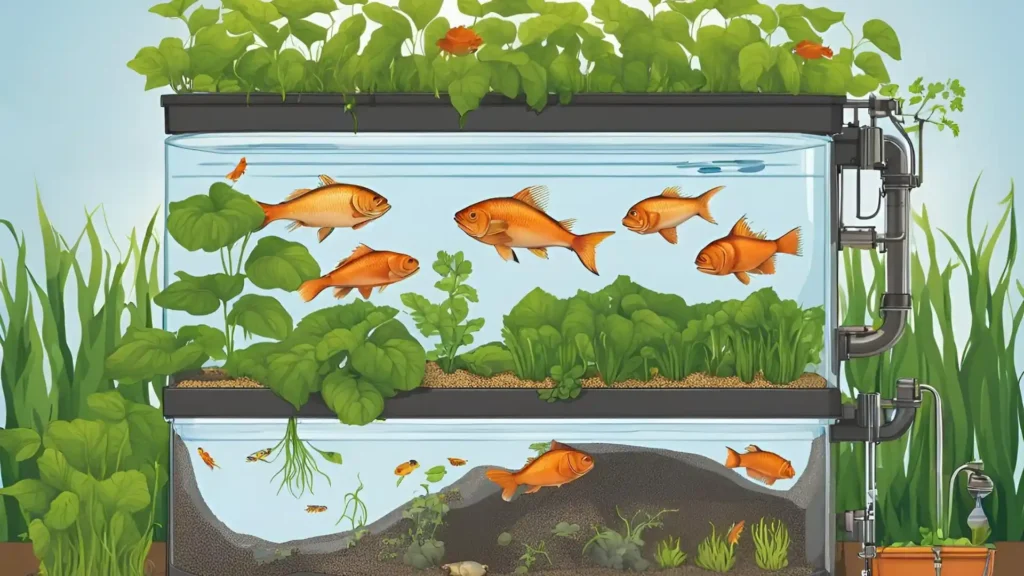Home » Aquaponics Farming

Aquaponics Farming
Aquaponics Farming: Eco-friendly and Perennial Harvesting
Aquaculture and hydroponics come together in this cutting-edge innovation named Aquaponics Farming. Essentially, it is a symbiotic ecosystem by itself. Moreover, it is regarded as a significant advancement in agricultural technology. As a result, its popularity is soaring by the day. This innovation integrates fish cultivation with soilless cultivation techniques. Operating within a closed-loop system, it improves resource efficiency for growing fresh produce all year round. Furthermore, it enables a lower use of chemical fertilizer and pesticides so that they utilize the water resources available to a maximum extent. Honestly, it has been an excellent eco-friendly way to help alleviate the world food shortages.
Aquaponics Farming: Let Us Know About It
Aquaponics is, by itself, a sustainably symbiotic ecosystem. It fosters the growth of both plants and fish in a healthy environment. The nutritional essentials for plant growth come from fish waste, while plants clean water for safe consumption by fish. It requires much less water than conventional farming as it runs in a loop, making it a sustainable option. It also minimizes environmental impact and does not depend on chemical fertilizers. Outdoors or indoors, aquaponics is an adaptable alternative. Various climatic zones and locations are not a deterrent for this farming method.

Aquaponics Farming- Advantages
Year-Round Food Production
Aquaponics farming enables year-round cultivation, unlike conventional farming which depends on seasons. Indoor systems provide controlled conditions, ensuring continuous harvests regardless of external weather conditions.
Water Conservation
Aquaponics uses 90% less water than traditional soil agriculture. Recirculating water in a loop continuously proves its high resource efficiency while saving massive waste of valuable water.
No Chemical Fertilizers
Fish waste produces nutrition, so chemical and toxic fertilizers are unnecessary. This results in organic and chemical-free produce.
Enhanced Yields and Accelerated Growth
Plants experience faster growth when exposed to nutrient-dense water compared to traditional soil. This results in increased yields within a more compact area.
Reduced Land Requirement
Ideal for urban spaces, moreover, sizeable fields are not necessary to start aquaponics farming. In addition, warehouses, greenhouses, or your homes can accommodate compact systems.
How Does Aquaponics Farming Work?
The Fish Tank
The fish tank serves as the principal source, as a result, providing nutrients for the system. Essential nitrogen and valuable nutrients that plants feed on are naturally produced from the accumulated fish waste in the tank. Trout, Catfish, and Tilapia are popular fish employed in this process.
The Grow Bed
Nutrients produced by fish waste eventually reach as food for the plants on these grow beds. Meanwhile, DCW systems and NFT channels (Deep Water Culture and Nutrient Film Technique, respectively) are media beds employed in aquaponics.
Filtration System and Water Pump
Water is cleaned by a filtration system by removing solid waste. Consequently, this provides clean water for fish to thrive. Additionally, water is circulated by a pump to the grow bed from the fish tank.
The Symbiotic Cycle
Plants purify and filter the water after feeding on the nutrients. Thus, the symbiotic cycle is completed by clean water flowing back to the fish tank via recirculation.
Aquaponics System- How to Set One Up
Choose the Right Location
Sufficient light and air circulation are a must for an aquaponics set-up. Indoor setups would need Grow Lamps.
The Right Fish to Employ
In particular, resilient fish varieties like Jade Perch, Yellow Perch, Trout, Carp, Slender Danios, Tilapia, and Catfish are common aquaponics inhabitants.
The Right Plants for Aquaponics
Here is a representative list of vegetables, greens, and herbs. For instance, Tomatoes, Peppers, Cucumbers, Arugula, Spinach, Bok Choy, Kale, Swiss Chard, Lettuce, Rosemary, Cilantro, Oregano, and Thyme are a few examples. Therefore, check growing conditions, ask around, and grow.
Maintain the Right Water Conditions
To begin with, levels of important factors like oxygen, ammonia, nitrate, and pH should be inspected with discipline regularly. When properly maintained, fish and plants will love to grow and flourish in an aquaponics setup with a balanced and stable environment.
Use a Robust Filtration System
A biofilter helps convert fish waste into nutrients for plants. Proper filtration ensures the system remains balanced.
Sustainability of Aquaponics Farming
Reduced Carbon Footprint
Localized aquaponics farms minimize carbon emissions by avoiding long-distance transportation.
Less Environmental Pollution
Non-dependence on toxic pesticides and chemical fertilizers minimizes soil and water pollution to a very large extent.
| Fish Used in Aquaponics | Plants Grown in Aquaponics |
|---|---|
| Jade Perch | Tomatoes |
| Trout | Peppers |
| Slender Danios | Arugula |
| Tilapia | Spinach |
| Catfish | Bok Choy |
| Yellow Perch | Kale |
| Carp | Lettuce |
| Swiss Chard | |
| Rosemary | |
| Cilantro | |
| Oregano | |
| Thyme |
Summary
Aquaponics farming takes sustainable farming to a higher level of an innovative symbiotic ecosystem. Using 90 percent less water than traditional farming methods based on soil, it is a most resourceful process. Organic harvests come to our table via aquaponics, bypassing chemical fertilizers and toxic pesticides. Notably, nutrient-rich fish waste feeds the plants, and in return, the greens clean the water for the fish in a looped recirculation manner. While there are large aquaponics projects, they fit well in small zones in urban setups with their compact designs. Moreover, they adapt to different area sizes and reduce environmental harm. Fish tanks, grow beds, pumps, and filters are the primary requirements for indoor or outdoor setups. This innovative farming method saves water, cuts emissions, and reduces pollution, Aquaponics helps the process and goal of a long-term solution to global food challenges.
FAQs
1. Is it costly to begin an aquaponics farm?
Do not be concerned by the upfront cost that may seem high. However, with a little patience and time, you will realise the big savings you have made. In fact, you will save on many fronts, like 90% less water usage, no high-priced fertilizers or pesticides, and minimal maintenance.
2. Which are the best fish varieties for aquaponics?
Consult other aquaponic uses online or offline for advice. They may vary from one climatic region to another. Adaptable and resilient fish like perch, carp, slender danios, catfish, tilapia, and trout can withstand various climatic zones.
3. Can I install aquaponics at home?
Yes! Moreover, with less need for space or expenses, it can be set up indoors or in backyards.
4. How to maintain an aquaponics system properly?
Maintenance is much less than traditional soil-based agriculture. Test water, feed fish, and keep the filtration system up to date regularly.
5. For kitchen décor, which are the best aquaponics-grown plants?
Additionally, lettuce, kale, spinach, Swiss chard, tomatoes, peppers, and various herbs growing well in aquaponics farming can cheer up your kitchen decor.
Trending Topics
Large Indoor Plants, Guest Bedroom Ideas, Leather Sectional, Minimalist Home Decor Ideas Hydroponics Farming, Minimalist Home Decor Ideas, Outdoor Plant Stand, Alternative Home Decor Ideas – Think Laterally, Summer Plants, DIY Vertical Garden, The Benefits of Closed-Loop Gardening, Diy Gardening, Sustainable Materials, Garden Hoe, Gardening as Therapy, Permaculture, Muhly Grass Care, Wheelbarrow, DIY Garden Ideas, DIY Greenhouse, Cheap DIY Garden Path Ideas, DIY Garden Fence, Snowball Bush, Sustainable Design, Sustainability and Home Decor, Small Kitchen Table Sets For 4, Outdoor Sectional Couch, How To Care For a Peace Lily Indoors, Plant Stand Indoor Walmart, Plant Stand Indoor With Grow Lights, Plant Stand Indoor Tall, Plant Stand Indoor Amazon, Kitchen Decor, Plant Stand Indoor, Snake Plant Benefits, Kitchen Decor Ideas



Pingback: Hydroponics Farming - ytvblog.com
Pingback: Zebra Plant
Pingback: Garden Hoe